Researching an Unfamiliar Object – Business of Doing Business – The Journal of Antiques and Collectibles – May 2004
By Ed Welch
Antique dealers and collectors are sometimes tempted to buy items with unknown identities. They could be rare or previously undocumented examples of something the dealer is already interested in. Identifying a rare example can be exciting, and the financial payoff can be considerable. Of course, the downside is that a dealer can spend much money doing research only to discover the item is something other than expected.
I specialize in medical, dental, and optical antiques, especially vision aids used before the invention of eyeglasses with temples. (Before Edward Scarlett, an English optician, came up with the idea of temples in 1727, all reading aids were handheld, suspended from a visor-like band worn around the head, suspended attached to the brims of hats, balanced precariously on the nose, and in some cases rested upon tables.) Several years ago, I had the opportunity to purchase a large globe. The owner explained that the globe was a vision aid used by the Irish linen trade. By placing a candle at the top, Irish linen workers could work well into the night. At the time, I did not know if this was the correct description for the use of this item. However, I was intrigued by the possibility and paid a rather hefty price for it.
I am a member of two optical collecting societies, so I have access to reference material not commonly available to the public. I also own an extensive library related to the optical trade. I have found several references to reading globes. This leads me to believe that reading globes as a vision aid do, or did, exist. But none of my references mention the use of a candle to illuminate the text of a book so that it could be read at night. And I have found no references to the use of a globe in the Irish linen trade.
I decided to conduct my own experiments to see if, in fact, this globe would magnify text and, with the use of a candle, make it possible for the text to be read at night in a dark room. Photo one shows the globe with a wine glass and a candle for size comparison. The wine glass is 6 inches tall; the candle is 10 inches long. The globe is 13-1/2 inches tall. The frosted base is 4 inches high. The diameter of the globe is 6-1/2 inches. The neck of the globe is 3 inches tall, and its inside diameter is 1 inch. The globe is hand blown; the frosted base is hand blown and then attached to the globe. The pontil mark on the bottom of the globe is not visible in this photo, but it clearly shows in photo two, where the text of a medical book is viewed through the globe. The globe is empty. No water has been added. Note that there is no magnification of the text of the book.
Photo three shows the text of the book after the globe has been filled with water. Notice that the text is clearly larger. The water-filled globe clearly acted as a large magnifying glass. Also, notice that only the text in the very center of the globe is in a straight line so that it can easily be read. Text located outside the very center of the globe is distorted. This is a sign that the globe may have been purposely made as a vision aid. All lenses including the lenses in all eyeglasses exhibit the same phenomena. Only the very center of eyeglass lenses produce clear undistorted vision. The further from the center of the lens, the more distorted the viewed item becomes.
Luckily, I own a French leech bowl mounted on a clear glass pedestal. I filled the leech bowl with water. The water-filled leech bowl also magnified text. However, its shape being more squat tended to distort the text. When I attempted to illuminate the text using a candle in a dark room, the result was also poor. Light streaks and glare spots reflected back through the globe from the clear glass pedestal.
The distance and the angle that the book is held impact the distortion of the text. Best results were achieved when the book was approximately eight to 12 inches behind the globe and held nearly perpendicular to the globe. The distance of my eyes from the globe also played an important part. If I adjusted the globe before me so that the distance from my eyes to the globe was approximately 12 to 18 inches, I could view a large portion of the printed page without distortion.
I conducted my experiments in the evenings over a three-day period. On the third day, a customer interrupted me. I, of course, had to take a few minutes to explain to this person the water-filled globe, the candle, and my experiments. Our business transactions took nearly an hour. During this time, I neglected to extinguish the candle flame. My customer left, and I returned to my experiment. The candle was now just over four inches tall. To my surprise, the short candle put more light on the text of the book. When I began to experiment with candle length, I discovered that the globe works best with a candle length between 2-1/2 and 5-1/2 inches tall.
My experiments convinced me that a water-filled globe will magnify text and, in conjunction with a candle, will magnify and illuminate text so that it can be read at night. I am also convinced that the shape of the globe is important. If a globe is mounted on a base, the base must be frosted or made of some material that does not reflect light easily. I have made some significant observations about this object. And yet, I am still not sure if I own a reading globe, a vision aid made for use in the Irish linen trade, or simply a fancy candlestick. And, alas, I have no idea of the age of this item. This object remains a mystery.
Any readers who may have information about this item are invited to contact Edward Welch. He can be reached via telephone by calling (207) 872-5849, by mail at RR # 3 Box 1290, Winslow, Maine 04901, or by email at edwelch@metiques.com

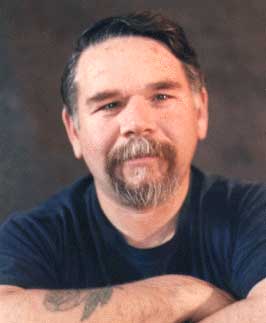
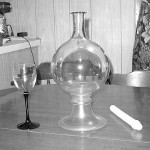
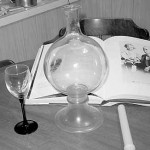
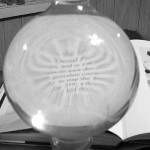
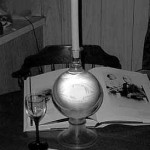



Related posts: